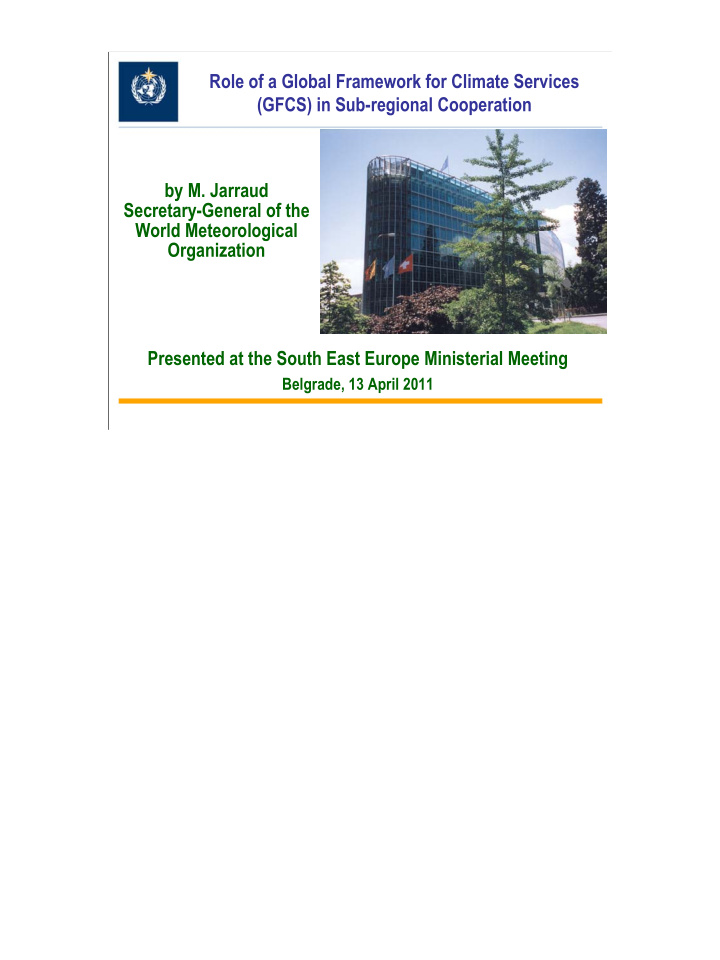



Role of a Global Framework for Climate Services (GFCS) in Sub-regional Cooperation by M. Jarraud Secretary-General of the World Meteorological Organization Presented at the South East Europe Ministerial Meeting Belgrade, 13 April 2011 1
Decisive role of SEE partnerships � 6 th Ministerial UNECE Conference “Environment for Europe” (Belgrade, October 2007) � Belgrade Initiative on Climate Change � SEE Climate Change Framework Action Plan (SEE/CCFAP) � SEE Sub-regional Virtual Climate Change related Centre (SEE/VCCC) in Belgrade � South East European Climate Change Action Plan for Adaptation (SEE/CCFAP-A) (Sarajevo, Nov. 2008) � South Eastern Europe Disaster Risk Mitigation and Adaptation Programme (SEEDRMAP) 2 2
NMHSs role in communicating weather & climate services & contributing to disaster risk reduction � Key role of the National Meteorological and Hydrological Services (NMHSs) � Disaster risk reduction � Severe weather warnings & advisories � Supporting community response measures � Nuclear, biological and chemical (NBC) pollutant dispersion monitoring/prediction 3
Communicating weather & climate services contributes to extend their benefits to all socioeconomic sectors � Madrid Conference (2007) � Examples: Agriculture & food security, health, water resources management, transport, tourism... 4 4
A seamless transition from weather to climate prediction 5
Observations & monitoring � WMO Integrated Global Observing Systems (WIGOS) implementation � WMO Information System (WIS) development 6 • . 6
Need for authoritative research � Scientific partnerships � Assessments � Authoritative studies � Statements 7 7
WMO RA VI (Europe) Regional Climate Centre Network � WMO RCCs to become key GFCS components 8 8
South Eastern Europe Climate Outlook Forum (SEECOF) � The 1 st European Regional Climate Outlook Forum � SEECOF-I (Zagreb, June 2008) � SEECOF-II (Budapest, Nov. 2009) � SEECOF-III on-line, summer 2010 � SEECOF-IV (Belgrade, Nov. 2010) � Participants: Albania, Armenia, Azerbaijan, Bosnia, Bulgaria, Croatia, Cyprus, the former Yugoslav Republic of Macedonia, Georgia, Greece, Hungary, Israel, Moldova, Montenegro, Rumania, Serbia, Slovenia & Turkey 9 9
A historic event: WCC-3 (31 August-4 September 2009) � 1 st WCC (1979) � 2 nd WCC (1990) � WMO Cg-XV decision (2007) � Key outcome: A HLT to prepare a Report with recommendations for GFCS development 10
8 implementation principles � Prioritize capacity building for developing countries � Greater availability of climate services for all countries � 3 geographic domains: global, regional and national � A core GFCS element: operational climate services � Governments to have a central role in GFCS management, but each country will decide just how � Free and open exchange of observational data, while respecting national and international data policies � To facilitate and to strengthen, but not to duplicate � Based on user – provider partnerships which will include all major stakeholders 11 11 11
GFCS recommended structure 12 12 12
HLT report structure 13 13
Governance proposals 14 14
Initial GFCS priorities � Although the GFCS will progressively support all key socioeconomic sectors, for the first 4 years the HLT has proposed to prioritize: � Agriculture � Disaster risk reduction � Health � Water � These sectors are interconnected 15 15
Next steps in GFCS development � By end 2011 a detailed implementation plan and inaugural Intergovernmental plenary meeting � By end 2013 the organizational phase to be completed, including a secretariat & management structures � By end 2017 global access to improved climate services for selected priority sectors � By end 2021 improved climate services globally across most climate-sensitive sectors 16
Developing a climate user interface � A new concept to bridge the gap between climate services providers and the end-users � Differing needs � No predefined solution-for-all � Various spatial & temporal scales � From the grassroots to a regional/global approach � Communication & visibility 17
Summing up � International cooperation & Multidisciplinary partnerships � Complementary roles of government, research, academia, private sector, the media,... � Effective incorporation of adaptation best practices � 2 correlated issues: � Climate variability and change adaptation � Disaster risk reduction � Enhanced capacity building at all levels � A key priority for WMO XVI th Congress (May 2011) 18
Thank you Thank you Thank you 19
Recommend
More recommend